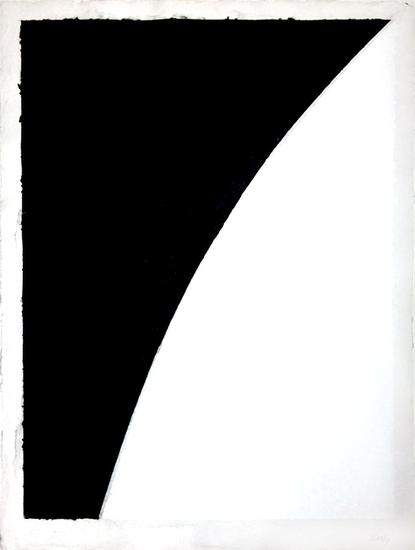
Ellsworth Kelly, “Colored Paper Image I (White Curve with Black I)”, 1976, Colored and pressed paper pulp, 46 1/2 x 32 1/2 inches
I always thought I would outgrow my affection for Ellsworth Kelly as I have with most twentieth century masters. My interest in Pablo Picasso lasted only a couple of years. I decided pretty early on that cubism, while historically important, didn’t have much direct influence on the contemporary art I liked. Jackson Pollock suffered similarly. He made great abstract expressionist drip paintings, but I never thought about them when I wasn’t in front of them. Why was Ellsworth Kelly so different?
Like many, I’m asking myself this question one day after Kelly’s announced death. He was 92.
In a different life, I sold his prints at a gallery I worked for in the mid aughts. I was told he was difficult—constantly concerned with secondary auction prices none of us had any control over. I liked knowing that, though, because it made him seem a little more human. He made a lot of machine-like renderings of simple shapes.
We didn’t handle his well-known large minimalist sculptures at the gallery. As an assistant, I helped mount shows of his minimalist prints from the 60’s and 70’s—simple shapes in a single color—Colored Paper Image 1 (White Curve with Black, I), Blue and Yellow and Red Orange, and Orange/Green. Most prints never got much larger than 50 inches. We also showed his hand drawn images of plants and flowers from the 70’s. I liked every single one of these prints, and when I left the gallery, my only regret was that I never tried to purchase one of them. I couldn’t afford any, but after a year of living with them, I knew I would never tire of the work.
Kelly could pair down any drawing, painting or sculpture into its most essential element. Cumulatively, I spent hours studying a single curve in some of these prints. I did this, not because there any great intellectual gains to be made in doing so, but because the shapes so perfectly completed themselves. It was an immensely satisfying experience just to look at them.
They defied my expectations for minimalism. Granted, I had not seen much when I first encountered his work. (This was in 2003.) But until then, I’d always questioned the popular idea that minimalist artworks demanded a physical response. I didn’t see how anything Kelly made could possibly change that point of view.
Boy, was I wrong. I found Kelly’s shapes near kinetic. Sometimes I couldn’t pull away from them. I had to re-evaluate. The work obviously had a physical affect on me.
This experience in the gallery, more than any other, taught me how powerful Kelly’s work and Minimalism as a whole could be. For that I will always be thankful.


Comments on this entry are closed.